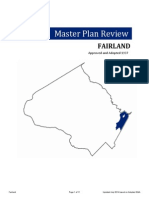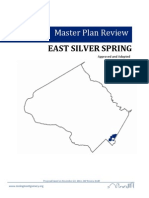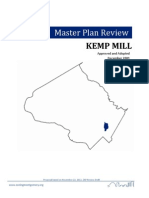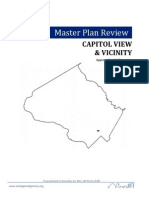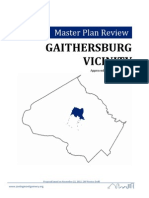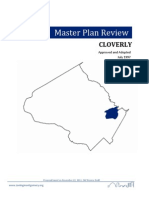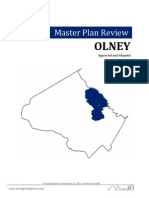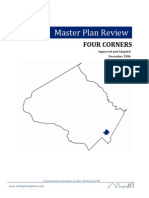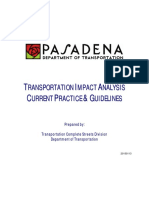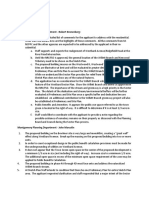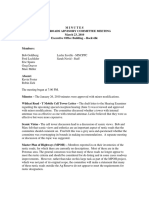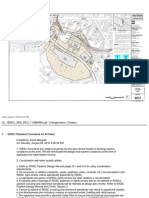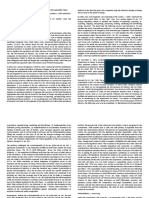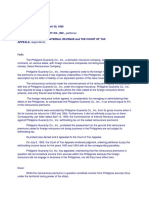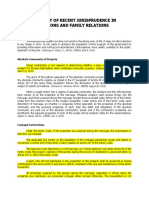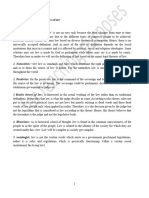0 ratings0% found this document useful (0 votes)
56 viewsUpper Rock Creek: Master Plan Review
Upper Rock Creek: Master Plan Review
Uploaded by
Planning DocsThe document summarizes the zoning code rewrite process in Montgomery County, Maryland. It discusses how the over 120 existing zones will be consolidated into about 30 proposed zones. For residential zones, many will remain the same while some similar zones will be combined. Commercial and industrial zones will also be consolidated based on use and context. The document then provides details about how existing zones in the Upper Rock Creek area will translate to the new proposed zones, with some being direct conversions and others based on master plan recommendations or existing approvals.
Copyright:
© All Rights Reserved
Available Formats
Download as PDF, TXT or read online from Scribd
Upper Rock Creek: Master Plan Review
Upper Rock Creek: Master Plan Review
Uploaded by
Planning Docs0 ratings0% found this document useful (0 votes)
56 views13 pagesThe document summarizes the zoning code rewrite process in Montgomery County, Maryland. It discusses how the over 120 existing zones will be consolidated into about 30 proposed zones. For residential zones, many will remain the same while some similar zones will be combined. Commercial and industrial zones will also be consolidated based on use and context. The document then provides details about how existing zones in the Upper Rock Creek area will translate to the new proposed zones, with some being direct conversions and others based on master plan recommendations or existing approvals.
Original Title
Untitled
Copyright
© © All Rights Reserved
Available Formats
PDF, TXT or read online from Scribd
Share this document
Did you find this document useful?
Is this content inappropriate?
The document summarizes the zoning code rewrite process in Montgomery County, Maryland. It discusses how the over 120 existing zones will be consolidated into about 30 proposed zones. For residential zones, many will remain the same while some similar zones will be combined. Commercial and industrial zones will also be consolidated based on use and context. The document then provides details about how existing zones in the Upper Rock Creek area will translate to the new proposed zones, with some being direct conversions and others based on master plan recommendations or existing approvals.
Copyright:
© All Rights Reserved
Available Formats
Download as PDF, TXT or read online from Scribd
Download as pdf or txt
0 ratings0% found this document useful (0 votes)
56 views13 pagesUpper Rock Creek: Master Plan Review
Upper Rock Creek: Master Plan Review
Uploaded by
Planning DocsThe document summarizes the zoning code rewrite process in Montgomery County, Maryland. It discusses how the over 120 existing zones will be consolidated into about 30 proposed zones. For residential zones, many will remain the same while some similar zones will be combined. Commercial and industrial zones will also be consolidated based on use and context. The document then provides details about how existing zones in the Upper Rock Creek area will translate to the new proposed zones, with some being direct conversions and others based on master plan recommendations or existing approvals.
Copyright:
© All Rights Reserved
Available Formats
Download as PDF, TXT or read online from Scribd
Download as pdf or txt
You are on page 1of 13
Master Plan Review
Approved and Adopted April 2004
UPPER ROCK CREEK
Upper Rock Creek Page 1 of 13 Updated July 2014 based on Adopted DMA
Public Listening Session 9/2009
ONING CODE REWRITE
In 2007, the Montgomery County Council directed the Planning Department to undertake a
comprehensive zoning ordinance rewrite. Last rewritten in 1977, the current 1,200
+
page code is
viewed as antiquated and hard to use with standards that have failed to keep pace with modern
development practices.
With only about four percent of land in the County available for greenfield development, the new
zoning code can play a crucial role in guiding redevelopment to areas like surface parking lots and
strip shopping centers. An updated zoning code is important for achieving the kind of growth
Montgomery County policymakers and residents want.
Initial sections of the new code were drafted by Code
Studio, a zoning consultant. These drafts were
subsequently analyzed and edited by planners based
on feedback from the Zoning Advisory Panel (a citizen
panel appointed by the Planning Board to weigh in on
the projects direction), county agency representatives,
residents and other stakeholders. In September 2012,
planning staff began the release of a draft code in
sections accompanied by a report highlighting changes
from the current code. The staff drafts were reviewed
at length by the Planning Board.
The Planning Board held worksessions and public hearings between September of 2012 and May of
2013. On May 2, they transmitted their draft to the County Council. The Council adopted the text of
the new code in March and adopted the new zoning map in July 2014.
The new code and map will go into effect on October 30, 2014.
ZONE IMPLEMENTATION PROCESS
An important aspect of the Zoning Rewrite process is the potential simplification of 123 existing
zones into about 30 proposed zones. While some of the proposed zones are a direct one-to-one
translation of existing zones, others are the result of combining existing zones with similar
standards. Additionally, existing zones that are not currently mapped or are no longer used in the
County have been eliminated from the proposed code. Through the implementation process,
Montgomery County aims to simplify the number of zones, eliminate redundancy, and clarify
development standards. A full translation table for all zones can be found in the documents section
of our website: www.zoningmontgomery.org.
BACKGROUND
Upper Rock Creek Page 2 of 13 Updated July 2014 based on Adopted DMA
Agricultural, Residential, and Industrial Zone Implementation:
For agricultural and rural zones, the existing zones will be translated to proposed zones on a one-to-
one basis, with the exception of the Low Density Rural Cluster zone which is not currently used in
the County and will be eliminated.
Many of the existing residential zones will remain the same. Other residential zones will be
combined with existing zones that have similar development standards. The R-4Plex zone, which is
not currently mapped anywhere in the county, will be removed from the proposed code.
Implementation of Industrial zones will combine similar zones (Rural Service, I-1, and R+D) into the
proposed Industrial Moderate (IM) zone. The existing heavy industrial zone (I-2) will be renamed as
the Industrial Heavy (IH) zone.
Examples:
Agricultural
and Rural
Rural Density
Transfer (RDT)
Agricultural
Reserve (AR)
R-60
(detached residential)
R-60
(detached residential)
R-60/TDR
(detached residential)
Residential
Upper Rock Creek Page 3 of 13 Updated July 2014 based on Adopted DMA
Commercial and Mixed-Use Zone Implementation:
Parcels located in the existing Commercial, Mixed-use, Central Business District (CBD), and Transit
Station zones will be translated into one of the proposed Commercial/Residential (CR) or
Employment (E) Zones using a two-tiered process.
First, decisions about specific parcels in these zones were based on recommendations within the
Master Plan. Planning staff reviewed each Master Plan in the County. When the Master Plan
provided specific recommendations about allowed density, height, or mix of uses for individual
commercial or mixed-use parcels, those recommendations were used to build the formula of the
proposed zone. This ensures consistency with currently allowed density and height, and helps
codify Master Plan recommendations in a parcel-specific manner.
Second, if the Master Plan did not make specific recommendations, the current zone changed to a
proposed zone on a one-to-one basis or the proposed zone was determined using a specific
standardized decision tree (see example below). The standardized decision tree translates existing
zones by considering each specific parcels proximity to single-family neighborhoods or other
factors. The goal of the implementation decision tree is to retain currently allowed heights and
densities and maintain context sensitivity.
Example: C-1 Convenience Commercial
Confronts or abuts
R-150 or less intense
or site is bigger than 5 acres
NR-0.75
H-45
then
Within a Historic
District
NR-0.75
H-45
then
Confronts or abuts
R-90, R-60, R-40, or R-MH
CRT-0.75
C-0.75 R-0.25 H-35
then
Confronts or abuts RT
or more intense
CRT-0.75
C-0.75 R-0.25 H-45
then
C-1
if
Upper Rock Creek Page 4 of 13 Updated July 2014 based on Adopted DMA
PLAN HIGHLIGHTS
The Upper Rock Creek Area Master Plan was approved and adopted in April 2004. The Upper
Rock Creek Planning Area lies in the east central part of Montgomery County and encompasses
roughly 60% of the Upper Rock Creek Watershed. The environmental setting of the Upper Rock
Creek Area has significantly influenced the Plans two primary goals: protect the areas
environmental resources and stream quality, and to preserve the areas residential character.
To protect the areas environmental resources and stream quality, the Plan seeks to direct
development away from environmentally sensitive areas, preserve open space through creation
of low density zones for undeveloped properties, increase open space with easements or direct
acquisition, and apply an impervious surface cap to minimize impacts of development on water
quality. To preserve the areas residential character the Plan maintains low densities near river
valleys and along ridges and encourages that the design of future development be compatible
with the existing neighborhoods.
Two secondary goals of the Master Plan are to enhance neighborhood centers and industrial
areas and to connect communities. To achieve these goals, the Plan recommends providing
additional housing adjacent to the Redlands commercial area, retaining existing industrial
zoning, and developing a trail and bikeway network to improve access within the community.
UPPER ROCK CREEK
Agriculture History Farm Park
Upper Rock Creek Page 5 of 13 Updated July 2014 based on Adopted DMA
The Upper Rock Creek Planning Area currently has 13 zones: 1 Rural, 6 Residential, 2 Commercial, 3
Industrial, and 1 Planned Development
Existing Rural:
RNC: Rural Neighborhood Cluster
Existing Residential:
RE-1: Detached Unit, Single-Family
RE-1/TDR: Detached Unit, Single-Family
RE-2: Detached Unit, Single-Family
R-200: Detached Unit, Single-Family
R-90: Detached Unit, Single-Family
RT-12.5: Townhouse, Single-Family
Existing Commercial:
C-1: Convenience Commercial
C-4: Limited Commercial
Existing Industrial
I-1: Light Industrial
I-4: Light Industrial
I-2: Heavy Industrial
Existing Planned Development:
PD-2: Planned Development
The existing RNC zone will remain RNC.
The existing RE-1 and RE-1/TDR zones will be combined into the proposed RE-1 zone. The RE-2 will
remain RE-2. The R-200 will remain R-200 (Residential Low Density). The existing R-90 will remain R-90
(Single-Family, Medium-Density). The existing RT-12.5 will remain. The residential TDR zones will be
incorporated into a new TDR Overlay zone.
The existing I-1 will be renamed IM (Industrial Moderate) and the I-4 zone will change to the proposed IL
(Industrial Light) zone. The existing I-2 zone will be renamed IH (Industrial Heavy). The existing PD-2
zone will remain the PD-2 zone.
The existing C-1 zone translates to CRT (Commercial Residential Town) and NR (Neighborhood Retail),
and the C-4 zone will translate to CRT (Commercial Residential Town). The translation is based on the
location and context for each of the parcels located in the zone. Each parcels proximity to residential
neighborhoods was considered in the translation decision, with the overall goal to retain currently
allowed heights and densities and maintain context sensitivity.
ZONE IMPLEMENTATION
Upper Rock Creek Page 6 of 13 Updated July 2014 based on Adopted DMA
In some cases, properties were not converted using the standard conversions as outlined earlier in the
packet.
Generally, this is because the relevant Master or Sector Plan made recommendations regarding the
appropriate density, height, or mix of uses on a given site.
In other cases, the text of the zoning ordinance or an overlay zone can affect the development potential
of a site, and therefore affect the conversion given as part of the draft proposed DMA.
Additionally, the PHED Committee instructed that, when requested by a property owner, existing site
approvals be reflected in the draft proposed DMA. Non-standard conversions sometimes reflect these
project approvals.
The following pages will give detail on all of the non-standard conversions in this plan area.
NON-STANDARD CONVERSIONS
Upper Rock Creek Page 7 of 13 Updated July 2014 based on Adopted DMA
MP Number: UPROK-01
Master Plan: Upper Rock Creek
Location: 108 near Meredith Drive
Existing Zone: C-4
Standard Conv: None
Proposed Conv: CRT-0.25 C-0.25 R-0.25 H-35
M
o
d
i
f
i
c
a
t
i
o
n
s
Zone Group: -
Overall FAR: -
Comml FAR: -
Residl FAR: -
Height: -
Reason for non-standard conversion:
This property is in the Upper Rock Creek Overlay, which limits
impervious cover, and therefore is not appropriate for higher intensity
commercial development; it is also not recommended for sewer and
septic.
Upper Rock Creek Page 8 of 13 Updated July 2014 based on Adopted DMA
Upper Rock Creek
Existing Proposed
Zone Acres Percent Zone Acres Percent
RNC
840.41 8.30
RNC
840.41 8.30
RE-1
3,945.44 38.96
RE-1 4,072.59 40.21
RE-1/TDR
127.15 1.26
RE-2
3,658.96 36.13
RE-2
3,658.96 36.13
R-200
968.62 9.56
R-200
968.62 9.56
R-90
15.47 0.15
R-90
15.47 0.15
RT-12.5
26.99 0.27
RT-12.5
26.99 0.27
C-1 11.89 0.12
CRT-0.75 C-0.75 R-0.25 H-45
8.88 0.09
NR-0.75 H-45
3.01 0.03
C-4 3.58 0.04 CRT-0.25 C-0.25 R-0.25 H-35 3.58 0.04
I-1
237.51 2.35
IM-2.5 H-50
237.51 2.35
I-4
54.15 0.53
IL-1.0 H-50
54.15 0.53
I-2
147.20 1.45
IH-2.5 H-70
147.20 1.45
PD-2
89.75 0.89
PD-2
89.75 0.89
Grand
Total
10,289.21 Grand Total 10,289.21
ZONE IMPLEMENTATION
Upper Rock Creek Page 9 of 13 Updated July 2014 based on Adopted DMA
Upper Rock Creek: Existing Zoning
Rural
Residential Estate
Residental Low Density
Residential Medium Density
Townhouse
Commercial
Light Industrial, Low Inten.
Light Industrial
Heavy Industrial
Planned Development
Upper Rock Creek: Proposed Zoning
Rural
Residential Estate
Residental Low Density
Residential Medium Density
Townhouse
Comm/Res - Town
Neighborhood Retail
Light Industrial
Moderate Industrial
Heavy Industrial
Planned Development
ZONE IMPLEMENTATION
Upper Rock Creek Page 10 of 13 Updated July 2014 based on Adopted DMA
Rural
RNC
RE-1
RE-1/TDR
RE-2
R-200
R-90
Townhouse
RT-12.5
Commercial
C-1
C-4
Light Industrial
I -1
I -4
Heavy Industrial
I -2
PD-2
Residential
Medium Density
Planned
Development
Existing Zones
Residential
Estate
Residential Low
Density
EXISTING ZONING MAP
Upper Rock Creek Page 11 of 13 Updated July 2014 based on Adopted DMA
Rural
RNC
RE-1
RE-2
R-200
R-90
Townhouse
RT-12.5
CRT
NR
Light Industrial
I L
Mod. Industrial
I M
Heavy Industrial
I H
PD-2
Residential
Medium Density
Comm/Res-
Town
Neighborhood
Retail
Planned
Development
Proposed Zones
Residential
Estate
Residential Low
Density
PROPOSED ZONING MAP
Upper Rock Creek Page 12 of 13 Updated July 2014 based on Adopted DMA
PLANNING AREA CONTEXT
Upper Rock Creek Page 13 of 13 Updated July 2014 based on Adopted DMA
You might also like
- Ar 95-1 (2014)Document82 pagesAr 95-1 (2014)Anselmo Alvarez GonzalezNo ratings yet
- Master Plan Review: CloverlyDocument11 pagesMaster Plan Review: CloverlyPlanning DocsNo ratings yet
- Master Plan Review: FairlandDocument11 pagesMaster Plan Review: FairlandPlanning DocsNo ratings yet
- Master Plan Review: Clarksburg & Hyattstown Special Study AreaDocument17 pagesMaster Plan Review: Clarksburg & Hyattstown Special Study AreaPlanning DocsNo ratings yet
- Master Plan Review: Kemp MillDocument10 pagesMaster Plan Review: Kemp MillPlanning DocsNo ratings yet
- Master Plan Review: North & West Silver SpringDocument11 pagesMaster Plan Review: North & West Silver SpringPlanning DocsNo ratings yet
- Master Plan Review: White OakDocument11 pagesMaster Plan Review: White OakPlanning DocsNo ratings yet
- Master Plan Review: Forest GlenDocument10 pagesMaster Plan Review: Forest GlenPlanning DocsNo ratings yet
- Master Plan Review: DamascusDocument19 pagesMaster Plan Review: DamascusPlanning DocsNo ratings yet
- Master Plan Review: Preservation of Agriculture & Rural Open SpaceDocument11 pagesMaster Plan Review: Preservation of Agriculture & Rural Open SpacePlanning DocsNo ratings yet
- Master Plan Review: WestbardDocument15 pagesMaster Plan Review: WestbardPlanning DocsNo ratings yet
- Gaithersburg Vicinity: Master Plan ReviewDocument11 pagesGaithersburg Vicinity: Master Plan ReviewPlanning DocsNo ratings yet
- Master Plan Review: Sandy Spring - AshtonDocument16 pagesMaster Plan Review: Sandy Spring - AshtonPlanning DocsNo ratings yet
- Master Plan Review: Aspen HillDocument13 pagesMaster Plan Review: Aspen HillPlanning DocsNo ratings yet
- Silver Spring East: Master Plan ReviewDocument11 pagesSilver Spring East: Master Plan ReviewPlanning DocsNo ratings yet
- Master Plan Review: Silver Spring CBDDocument27 pagesMaster Plan Review: Silver Spring CBDPlanning DocsNo ratings yet
- Burtonsville Crossroads: Master Plan ReviewDocument13 pagesBurtonsville Crossroads: Master Plan ReviewPlanning DocsNo ratings yet
- Master Plan Review: OlneyDocument11 pagesMaster Plan Review: OlneyPlanning DocsNo ratings yet
- Master Plan Review: WheatonDocument13 pagesMaster Plan Review: WheatonPlanning DocsNo ratings yet
- Upper Rock Creek: Master Plan ReviewDocument11 pagesUpper Rock Creek: Master Plan ReviewPlanning DocsNo ratings yet
- Master Plan Review: Woodmont TriangleDocument18 pagesMaster Plan Review: Woodmont TrianglePlanning DocsNo ratings yet
- Master Plan Review: Kensington - WheatonDocument11 pagesMaster Plan Review: Kensington - WheatonPlanning DocsNo ratings yet
- East Silver Spring: Master Plan ReviewDocument11 pagesEast Silver Spring: Master Plan ReviewPlanning DocsNo ratings yet
- Master Plan Review: DamascusDocument16 pagesMaster Plan Review: DamascusPlanning DocsNo ratings yet
- Master Plan Review: GlenmontDocument11 pagesMaster Plan Review: GlenmontPlanning DocsNo ratings yet
- Master Plan Review: Bethesda - Chevy ChaseDocument13 pagesMaster Plan Review: Bethesda - Chevy ChasePlanning DocsNo ratings yet
- Master Plan Review: Shady GroveDocument26 pagesMaster Plan Review: Shady GrovePlanning DocsNo ratings yet
- Master Plan ReviewDocument15 pagesMaster Plan ReviewPlanning DocsNo ratings yet
- Master Plan Review: Takoma LangleyDocument11 pagesMaster Plan Review: Takoma LangleyPlanning DocsNo ratings yet
- Master Plan Review: KensingtonDocument11 pagesMaster Plan Review: KensingtonPlanning DocsNo ratings yet
- Master Plan Review: Aspen HillDocument13 pagesMaster Plan Review: Aspen HillPlanning DocsNo ratings yet
- Master Plan Review: Kemp MillDocument10 pagesMaster Plan Review: Kemp MillPlanning DocsNo ratings yet
- Master Plan Review: North & West Silver SpringDocument11 pagesMaster Plan Review: North & West Silver SpringPlanning DocsNo ratings yet
- Master Plan Review: White FlintDocument16 pagesMaster Plan Review: White FlintPlanning DocsNo ratings yet
- Master Plan Review: Friendship HeightsDocument18 pagesMaster Plan Review: Friendship HeightsPlanning DocsNo ratings yet
- Master Plan Review: Silver Spring CBDDocument20 pagesMaster Plan Review: Silver Spring CBDPlanning DocsNo ratings yet
- Master Plan Review: Capitol View & VicinityDocument10 pagesMaster Plan Review: Capitol View & VicinityPlanning DocsNo ratings yet
- Master Plan Review: FairlandDocument11 pagesMaster Plan Review: FairlandPlanning DocsNo ratings yet
- Master Plan Review: BoydsDocument13 pagesMaster Plan Review: BoydsPlanning DocsNo ratings yet
- Master Plan Review: Takoma ParkDocument34 pagesMaster Plan Review: Takoma ParkPlanning DocsNo ratings yet
- Master Plan Review: Forest GlenDocument10 pagesMaster Plan Review: Forest GlenPlanning DocsNo ratings yet
- Master Plan Review: Clarksburg & Hyattstown Special Study AreaDocument15 pagesMaster Plan Review: Clarksburg & Hyattstown Special Study AreaPlanning DocsNo ratings yet
- Master Plan Review: Sandy Spring - AshtonDocument15 pagesMaster Plan Review: Sandy Spring - AshtonPlanning DocsNo ratings yet
- Gaithersburg Vicinity: Master Plan ReviewDocument11 pagesGaithersburg Vicinity: Master Plan ReviewPlanning DocsNo ratings yet
- Master Plan Review: CloverlyDocument11 pagesMaster Plan Review: CloverlyPlanning DocsNo ratings yet
- Master Plan Review: WestbardDocument12 pagesMaster Plan Review: WestbardPlanning DocsNo ratings yet
- Master Plan Review: Bethesda CBDDocument27 pagesMaster Plan Review: Bethesda CBDPlanning DocsNo ratings yet
- Master Plan Review: White OakDocument11 pagesMaster Plan Review: White OakPlanning DocsNo ratings yet
- Master Plan Review: Long BranchDocument11 pagesMaster Plan Review: Long BranchPlanning DocsNo ratings yet
- Master Plan Review: Shady GroveDocument18 pagesMaster Plan Review: Shady GrovePlanning DocsNo ratings yet
- Master Plan Review: OlneyDocument11 pagesMaster Plan Review: OlneyPlanning DocsNo ratings yet
- Chevy Chase Lake: Master Plan ReviewDocument13 pagesChevy Chase Lake: Master Plan ReviewPlanning DocsNo ratings yet
- Master Plan Review: Four CornersDocument11 pagesMaster Plan Review: Four CornersPlanning DocsNo ratings yet
- Great Seneca Science Corridor: Master Plan ReviewDocument21 pagesGreat Seneca Science Corridor: Master Plan ReviewPlanning DocsNo ratings yet
- Master Plan Review: Capitol View & VicinityDocument10 pagesMaster Plan Review: Capitol View & VicinityPlanning DocsNo ratings yet
- Master Plan Review: Takoma ParkDocument14 pagesMaster Plan Review: Takoma ParkPlanning DocsNo ratings yet
- Master Plan Review: Kensington - WheatonDocument11 pagesMaster Plan Review: Kensington - WheatonPlanning DocsNo ratings yet
- Master Plan Review: Bethesda Purple Line StationDocument11 pagesMaster Plan Review: Bethesda Purple Line StationPlanning DocsNo ratings yet
- Master Plan Review: PotomacDocument19 pagesMaster Plan Review: PotomacPlanning DocsNo ratings yet
- Master Plan Review: Woodmont TriangleDocument15 pagesMaster Plan Review: Woodmont TrianglePlanning DocsNo ratings yet
- A Brighter Future for Maldives Powered by Renewables: Road Map for the Energy Sector 2020–2030From EverandA Brighter Future for Maldives Powered by Renewables: Road Map for the Energy Sector 2020–2030No ratings yet
- HPC WORKSESSION - 7:00 P.M. in Third Floor Conference Room HPC MEETING - 7:30 P.M. in MRO AuditoriumDocument2 pagesHPC WORKSESSION - 7:00 P.M. in Third Floor Conference Room HPC MEETING - 7:30 P.M. in MRO AuditoriumPlanning DocsNo ratings yet
- Development Review Committee Monday, October 3, 2016 9:30 A.MDocument1 pageDevelopment Review Committee Monday, October 3, 2016 9:30 A.MPlanning DocsNo ratings yet
- Label - Name Type Ftype - Name From - TO - Mplan RW MP - ClassDocument2 pagesLabel - Name Type Ftype - Name From - TO - Mplan RW MP - ClassPlanning DocsNo ratings yet
- T I A C P & GDocument28 pagesT I A C P & GPlanning DocsNo ratings yet
- Planning Board Draft September 14, 2016Document36 pagesPlanning Board Draft September 14, 2016Planning DocsNo ratings yet
- HPC WORKSESSION - 7:00 P.M. in Third Floor Conference Room HPC MEETING - 7:30 P.M. in MRO AuditoriumDocument2 pagesHPC WORKSESSION - 7:00 P.M. in Third Floor Conference Room HPC MEETING - 7:30 P.M. in MRO AuditoriumPlanning DocsNo ratings yet
- Orange: YellowDocument10 pagesOrange: YellowPlanning DocsNo ratings yet
- About ZTA 16-03: BACKGROUND: Planning Board RecommendationDocument1 pageAbout ZTA 16-03: BACKGROUND: Planning Board RecommendationPlanning DocsNo ratings yet
- Distinct Topics:: 1 - Preliminary Program of Requirements - NotesDocument6 pagesDistinct Topics:: 1 - Preliminary Program of Requirements - NotesPlanning DocsNo ratings yet
- UntitledDocument36 pagesUntitledPlanning DocsNo ratings yet
- Appendix G:: ParksDocument15 pagesAppendix G:: ParksPlanning DocsNo ratings yet
- Environment: Appendix FDocument41 pagesEnvironment: Appendix FPlanning DocsNo ratings yet
- Bicycle Master Plan Community Advisory Group Agenda Meeting #8 September 7, 2016 - 7:30 To 9:00 PM Montgomery County Planning DepartmentDocument1 pageBicycle Master Plan Community Advisory Group Agenda Meeting #8 September 7, 2016 - 7:30 To 9:00 PM Montgomery County Planning DepartmentPlanning DocsNo ratings yet
- Orange: YellowDocument10 pagesOrange: YellowPlanning DocsNo ratings yet
- Agenda: White Flint Sector Plan Implementation Advisory CommitteeDocument1 pageAgenda: White Flint Sector Plan Implementation Advisory CommitteePlanning DocsNo ratings yet
- Rental Housing Study: Financial Analysis and Swot FindingsDocument43 pagesRental Housing Study: Financial Analysis and Swot FindingsPlanning DocsNo ratings yet
- 2016 Subdivision Staging Policy: Planning Board Recommendation SummaryDocument33 pages2016 Subdivision Staging Policy: Planning Board Recommendation SummaryPlanning DocsNo ratings yet
- Rental Housing Study: Financial Analysis and Swot FindingsDocument43 pagesRental Housing Study: Financial Analysis and Swot FindingsPlanning DocsNo ratings yet
- Retail Planning Study: Appendix DDocument241 pagesRetail Planning Study: Appendix DPlanning DocsNo ratings yet
- Transportation: Appendix EDocument63 pagesTransportation: Appendix EPlanning DocsNo ratings yet
- Loop Trail: 15% Concept DesignDocument39 pagesLoop Trail: 15% Concept DesignPlanning DocsNo ratings yet
- HPC WORKSESSION - 7:00 P.M. in Third Floor Conference Room HPC MEETING - 7:30 P.M. in MRO AuditoriumDocument4 pagesHPC WORKSESSION - 7:00 P.M. in Third Floor Conference Room HPC MEETING - 7:30 P.M. in MRO AuditoriumPlanning DocsNo ratings yet
- Bethesda: Downtown PlanDocument65 pagesBethesda: Downtown PlanPlanning DocsNo ratings yet
- Montgomery Planning Department - Robert KronenbergDocument3 pagesMontgomery Planning Department - Robert KronenbergPlanning DocsNo ratings yet
- Development Review Committee Monday, September 19, 2016 9:30 A.MDocument1 pageDevelopment Review Committee Monday, September 19, 2016 9:30 A.MPlanning DocsNo ratings yet
- UntitledDocument2 pagesUntitledPlanning DocsNo ratings yet
- LEAD: John Marcolin: 320170010, Westwood Shopping Center Sketch Plan DRC Comments Summary Area Team 1Document12 pagesLEAD: John Marcolin: 320170010, Westwood Shopping Center Sketch Plan DRC Comments Summary Area Team 1Planning DocsNo ratings yet
- Vicinity Map: Owner/Applicant / Master DeveloperDocument7 pagesVicinity Map: Owner/Applicant / Master DeveloperPlanning DocsNo ratings yet
- Republic of Indonesia Department of Communications: Civil Aviation Safety Regulation (Casr)Document14 pagesRepublic of Indonesia Department of Communications: Civil Aviation Safety Regulation (Casr)nandaNo ratings yet
- Sports Wagering LetterDocument2 pagesSports Wagering LetterAsbury Park PressNo ratings yet
- Tatad v. Executive SecretaryDocument3 pagesTatad v. Executive SecretaryKristela AdraincemNo ratings yet
- CSS 105 - Class 1Document17 pagesCSS 105 - Class 1ipinmorotipNo ratings yet
- 4 - September 2015Document150 pages4 - September 2015jerwin rodelasNo ratings yet
- Sanjukta Swain - 18th BatchDocument13 pagesSanjukta Swain - 18th Batchnaiksiddhant408No ratings yet
- Francis Acosta Bribery PleaDocument8 pagesFrancis Acosta Bribery PleaReading_EagleNo ratings yet
- CPL and ATPL Theoretical Knowledge Examinations Study Material ReferencesDocument2 pagesCPL and ATPL Theoretical Knowledge Examinations Study Material ReferencessohanNo ratings yet
- Barcellano v. Banas, 2011 Case DigestDocument1 pageBarcellano v. Banas, 2011 Case DigestLawiswisNo ratings yet
- The Director of Lands Vs AbabaDocument2 pagesThe Director of Lands Vs AbabaJem PagantianNo ratings yet
- The Right To Adequate HousingDocument137 pagesThe Right To Adequate HousingOSGFNo ratings yet
- Eo-Barangay Nutrition CommitteeDocument2 pagesEo-Barangay Nutrition CommitteeMaulawin Pagsanjan100% (1)
- Odyssey Marine Exploration, Inc. v. The Unidentified Shipwrecked Vessel - Document No. 12Document4 pagesOdyssey Marine Exploration, Inc. v. The Unidentified Shipwrecked Vessel - Document No. 12Justia.comNo ratings yet
- Moot FormatDocument38 pagesMoot FormatSantosh GuptaNo ratings yet
- Motion For Reconsideration: Department of Agrarian Reform Adjudication BoardDocument6 pagesMotion For Reconsideration: Department of Agrarian Reform Adjudication BoardgiovanniNo ratings yet
- The Philippine Guaranty Co., Inc. Vs CirDocument2 pagesThe Philippine Guaranty Co., Inc. Vs CirBryne Angelo BrillantesNo ratings yet
- Member Form BSPPDocument1 pageMember Form BSPPramjanmahmood8No ratings yet
- A Survey of Recent Jurisprudence in Persons and Family RelationsDocument16 pagesA Survey of Recent Jurisprudence in Persons and Family RelationsJoelNo ratings yet
- Business Law HandoutDocument46 pagesBusiness Law HandoutHabtamu DugasaNo ratings yet
- 2015 - BaatzDocument39 pages2015 - BaatzAnnadeJesusNo ratings yet
- Corporate Social Irresponsibility Towards Investors-A Case Analysis of Sahara GroupDocument2 pagesCorporate Social Irresponsibility Towards Investors-A Case Analysis of Sahara GroupVaibhav SalaskarNo ratings yet
- SofappDocument6 pagesSofappAnonymous YjoaBucK4No ratings yet
- Rental AgreementDocument8 pagesRental AgreementMohsin SayedNo ratings yet
- Notes of Business Environment Unit 1Document5 pagesNotes of Business Environment Unit 1mohanraokp2279No ratings yet
- Intellectual Property Bar QuestionsDocument15 pagesIntellectual Property Bar QuestionsJulius AlcantaraNo ratings yet
- (Page 240 (1) ) : Sub S. (2) Act No. 3 of 2011 SubsectionDocument3 pages(Page 240 (1) ) : Sub S. (2) Act No. 3 of 2011 SubsectionJohnistobarNo ratings yet
- Adiarte v. C.ADocument2 pagesAdiarte v. C.AWendell MirabelNo ratings yet
- United States v. Peter Canessa, 644 F.2d 61, 1st Cir. (1981)Document5 pagesUnited States v. Peter Canessa, 644 F.2d 61, 1st Cir. (1981)Scribd Government DocsNo ratings yet
- RULE 113: ABADIANO, Joseph AGANA, Lance ASUNCION, Rogeniel FORTUNO, Nikki RONA, Ryan Miguel YU, OliverDocument21 pagesRULE 113: ABADIANO, Joseph AGANA, Lance ASUNCION, Rogeniel FORTUNO, Nikki RONA, Ryan Miguel YU, Olivermiguel uyNo ratings yet


